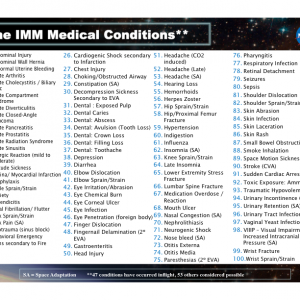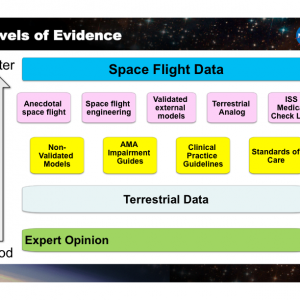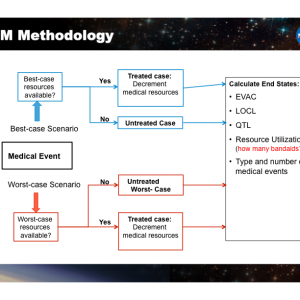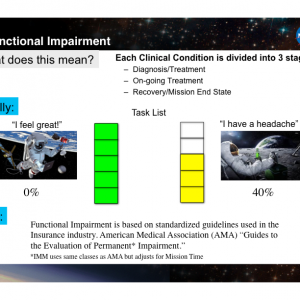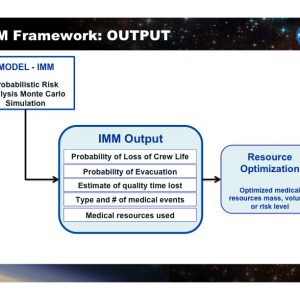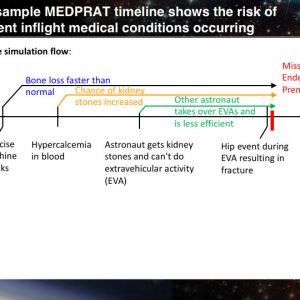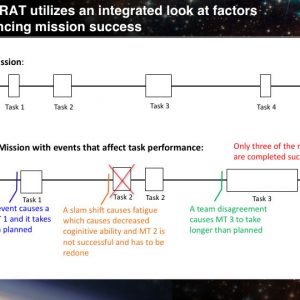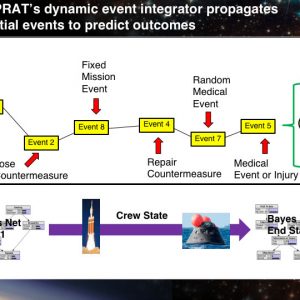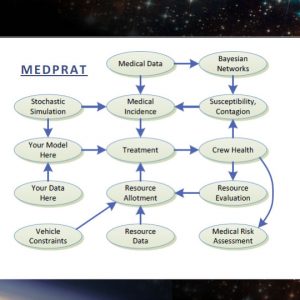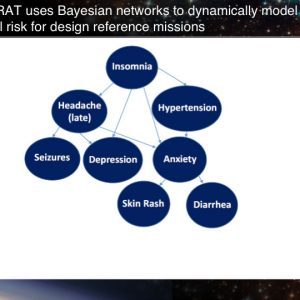Medical Risk Assessment
The Challenge
Quantifying risks associated with long duration exploration missions is essential to minimize negative impacts such as Loss of Crew Life, Evacuation and Quality Time Lost. Because mission planners view humans as one of several subsystems that comprise an exploration mission, the ability to quantify human risk enables mission planners to balance it against other system risks. Quantifying the risk also allows research managers to make informed research investment decisions aimed at obtaining the highest payoff in risk reduction.
The Research
Data gathered from the ISS expeditions and Space Shuttle missions, medical data from Apollo, Skylab, and Mir, as well as terrestrial analog data have been aggregated to create a database of medical condition incidence rates and treatment requirements. When provided with a notional mission scenario, the Medical Extensible Dynamic Probabilistic Risk Assessment Tool (MEDPRAT) builds off the capabilities originally developed for the Integrated Medical Model (IMM) using these data with its algorithm to forecast medical risk. The intent of this capability is to inform mission planning, research investments, and medical kit optimization.
The Progress
The Medical Extensible Dynamic Probabilistic Risk Assessment Tool (MEDPRAT) will ideally utilize the available space and terrestrial medical data and human health research to assess space flight medical risk in a manner consistent with other risk measures used in spacecraft and mission design. The tool will also be extensible to accommodate new data, findings, medical capabilities, missions, and outcomes. This tool then will provide risk based medical system design information necessary to evaluate new technologies, procedures, research insights and mission plans. MEDPRAT will dynamically incorporate the effects of a changing mission environment, such as the loss of a countermeasure, the failure of critical crew support systems in the vehicle, or an external event such as an increase in radiation flux. Additionally, because of the restricted set of conditions that NASA is planning to treat, NASA does not know the impact to human risk associated with a requirement that the crew medical officer be a trained physician. NASA is currently conducting studies to develop a metric quantifying performance differences in exploration mission scenarios. MEDPRAT will incorporate that metric and associated data to quantify the change in risk posture associated with requiring the crew medical officer to be a trained physician.
The Integrated Medical Model (IMM) delivers risk likelihood based on mission scenarios. The IMM project includes realistic timelines for when medical conditions arise and the effect on risk of providing a less than optimal treatment.
Acronyms
AMA – American Medical Association
IMM – Integrated Medical Model
ISS – International Space Station
Technical Data
- Predicting Bone Fracture in Astronauts
- Incidence rates for rare medical events.
- Predicting bone fracture during exploration missions.
- Head injury incidence rates on ISS.
Medical Risk Gaps
What is an HRP Gap?
Evidence from medical records, spaceflight operations and research findings provides the basis for identifying the most significant human risks in space exploration, including physiological and performance effects from hazards such as altered gravity, radiation, hostile/closed environments, isolation and distance. Each risk is assigned to an HRP Element (divisions of human research) to identify knowledge gaps, or the critical questions that must be answered, in order to mitigate the risk. These gaps become the focus of research conducted to reduce the likelihood and consequence of risks becoming a reality. To learn more about the Risk Identification and Mitigation process and the tasks developed to reduce those risks for the program please select the links below the for more information.
CV101 Cardiovascular Impacts from Weightlessness
Medical101 Medical Event Risk Metrics
Medical501 Integrated Exploration Medical System Models
Gallery
Cardiovascular Impacts
What are the in-flight alterations in cardiac structure and function?
Evidence from medical records, spaceflight operations and research findings provides the basis for identifying the most significant human risks in space exploration, including physiological and performance effects from hazards such as altered gravity, radiation, hostile/closed environments, isolation and distance. Each risk is assigned to an HRP Element (divisions of human research) to identify knowledge gaps, or the critical questions that must be answered, in order to mitigate the risk. These gaps become the focus of research conducted to reduce the likelihood and consequence of risks becoming a reality. To learn more about the Risk Identification and Mitigation process and the tasks developed to reduce those risks for the program please click on the link below the gap for more information.
Measuring VO2 inflight
What is VO2max in-flight and immediately post-flight?
Evidence from medical records, spaceflight operations and research findings provides the basis for identifying the most significant human risks in space exploration, including physiological and performance effects from hazards such as altered gravity, radiation, hostile/closed environments, isolation and distance. Each risk is assigned to an HRP Element (divisions of human research) to identify knowledge gaps, or the critical questions that must be answered, in order to mitigate the risk. These gaps become the focus of research conducted to reduce the likelihood and consequence of risks becoming a reality. To learn more about the Risk Identification and Mitigation process and the tasks developed to reduce those risks for the program please click on the link below the gap for more information.
Predicting Heart Disease
Can manifestations of sub-clinical or environmentally induced cardiovascular diseases during spaceflight be predicted?
Evidence from medical records, spaceflight operations and research findings provides the basis for identifying the most significant human risks in space exploration, including physiological and performance effects from hazards such as altered gravity, radiation, hostile/closed environments, isolation and distance. Each risk is assigned to an HRP Element (divisions of human research) to identify knowledge gaps, or the critical questions that must be answered, in order to mitigate the risk. These gaps become the focus of research conducted to reduce the likelihood and consequence of risks becoming a reality. To learn more about the Risk Identification and Mitigation process and the tasks developed to reduce those risks for the program please click on the link below the gap for more information.
Outcome of Medical Events
We do not know the quantified health and mission outcomes due to medical events during exploration missions.
Evidence from medical records, spaceflight operations and research findings provides the basis for identifying the most significant human risks in space exploration, including physiological and performance effects from hazards such as altered gravity, radiation, hostile/closed environments, isolation and distance. Each risk is assigned to an HRP Element (divisions of human research) to identify knowledge gaps, or the critical questions that must be answered, in order to mitigate the risk. These gaps become the focus of research conducted to reduce the likelihood and consequence of risks becoming a reality. To learn more about the Risk Identification and Mitigation process and the tasks developed to reduce those risks for the program please click on the link below the gap for more information.
Doctor on Board?
We do not know how the inclusion of a physician crew medical officer quantitatively impacts medical risk during exploration missions.
Evidence from medical records, spaceflight operations and research findings provides the basis for identifying the most significant human risks in space exploration, including physiological and performance effects from hazards such as altered gravity, radiation, hostile/closed environments, isolation and distance. Each risk is assigned to an HRP Element (divisions of human research) to identify knowledge gaps, or the critical questions that must be answered, in order to mitigate the risk. These gaps become the focus of research conducted to reduce the likelihood and consequence of risks becoming a reality. To learn more about the Risk Identification and Mitigation process and the tasks developed to reduce those risks for the program please click on the link below the gap for more information.
Microgravity Countermeasures
How does 1/6-g and 3/8-g influence countermeasures?
Evidence from medical records, spaceflight operations and research findings provides the basis for identifying the most significant human risks in space exploration, including physiological and performance effects from hazards such as altered gravity, radiation, hostile/closed environments, isolation and distance. Each risk is assigned to an HRP Element (divisions of human research) to identify knowledge gaps, or the critical questions that must be answered, in order to mitigate the risk. These gaps become the focus of research conducted to reduce the likelihood and consequence of risks becoming a reality. To learn more about the Risk Identification and Mitigation process and the tasks developed to reduce those risks for the program please click on the link below the gap for more information.
Efficient Exercise Regimen
Develop the most efficient and effective exercise program for the maintenance of muscle function.
Evidence from medical records, spaceflight operations and research findings provides the basis for identifying the most significant human risks in space exploration, including physiological and performance effects from hazards such as altered gravity, radiation, hostile/closed environments, isolation and distance. Each risk is assigned to an HRP Element (divisions of human research) to identify knowledge gaps, or the critical questions that must be answered, in order to mitigate the risk. These gaps become the focus of research conducted to reduce the likelihood and consequence of risks becoming a reality. To learn more about the Risk Identification and Mitigation process and the tasks developed to reduce those risks for the program please click on the link below the gap for more information.
Minimum Exercise Needed?
What is the minimum exercise regimen needed to maintain fitness levels for tasks?
Evidence from medical records, spaceflight operations and research findings provides the basis for identifying the most significant human risks in space exploration, including physiological and performance effects from hazards such as altered gravity, radiation, hostile/closed environments, isolation and distance. Each risk is assigned to an HRP Element (divisions of human research) to identify knowledge gaps, or the critical questions that must be answered, in order to mitigate the risk. These gaps become the focus of research conducted to reduce the likelihood and consequence of risks becoming a reality. To learn more about the Risk Identification and Mitigation process and the tasks developed to reduce those risks for the program please click on the link below the gap for more information.
Exercise Hardware
Identify and validate exploration countermeasure hardware for the maintenance of muscle function.
Evidence from medical records, spaceflight operations and research findings provides the basis for identifying the most significant human risks in space exploration, including physiological and performance effects from hazards such as altered gravity, radiation, hostile/closed environments, isolation and distance. Each risk is assigned to an HRP Element (divisions of human research) to identify knowledge gaps, or the critical questions that must be answered, in order to mitigate the risk. These gaps become the focus of research conducted to reduce the likelihood and consequence of risks becoming a reality. To learn more about the Risk Identification and Mitigation process and the tasks developed to reduce those risks for the program please click on the link below the gap for more information.
Time Course of Changes in Muscle
Characterize the time course of changes in muscle protein turnover, muscle mass, and function during long duration space flight.
Evidence from medical records, spaceflight operations and research findings provides the basis for identifying the most significant human risks in space exploration, including physiological and performance effects from hazards such as altered gravity, radiation, hostile/closed environments, isolation and distance. Each risk is assigned to an HRP Element (divisions of human research) to identify knowledge gaps, or the critical questions that must be answered, in order to mitigate the risk. These gaps become the focus of research conducted to reduce the likelihood and consequence of risks becoming a reality. To learn more about the Risk Identification and Mitigation process and the tasks developed to reduce those risks for the program please click on the link below the gap for more information.
Bone Health Standard
A new acceptable bone health standard using an expanded surrogate for bone health needs to be defined for the flight environment.
Evidence from medical records, spaceflight operations and research findings provides the basis for identifying the most significant human risks in space exploration, including physiological and performance effects from hazards such as altered gravity, radiation, hostile/closed environments, isolation and distance. Each risk is assigned to an HRP Element (divisions of human research) to identify knowledge gaps, or the critical questions that must be answered, in order to mitigate the risk. These gaps become the focus of research conducted to reduce the likelihood and consequence of risks becoming a reality. To learn more about the Risk Identification and Mitigation process and the tasks developed to reduce those risks for the program please click on the link below the gap for more information.
Osteoporosis & Fractures
What is the incidence & prevalence of early onset osteoporosis or fragility fractures due to exposure to spaceflight.
Evidence from medical records, spaceflight operations and research findings provides the basis for identifying the most significant human risks in space exploration, including physiological and performance effects from hazards such as altered gravity, radiation, hostile/closed environments, isolation and distance. Each risk is assigned to an HRP Element (divisions of human research) to identify knowledge gaps, or the critical questions that must be answered, in order to mitigate the risk. These gaps become the focus of research conducted to reduce the likelihood and consequence of risks becoming a reality. To learn more about the Risk Identification and Mitigation process and the tasks developed to reduce those risks for the program please click on the link below the gap for more information.
Ocular changes
We do not know the etiological mechanisms and contributing risk factors for ocular structural and functional changes seen in-flight and post-flight.
Evidence from medical records, spaceflight operations and research findings provides the basis for identifying the most significant human risks in space exploration, including physiological and performance effects from hazards such as altered gravity, radiation, hostile/closed environments, isolation and distance. Each risk is assigned to an HRP Element (divisions of human research) to identify knowledge gaps, or the critical questions that must be answered, in order to mitigate the risk. These gaps become the focus of research conducted to reduce the likelihood and consequence of risks becoming a reality. To learn more about the Risk Identification and Mitigation process and the tasks developed to reduce those risks for the program please click on the link below the gap for more information.
Medical Event Risk Metrics
We need to characterize the medical conditions that can occur during exploration missions and their relevant associated end states, management options, and the capabilities necessary to manage them (what can happen, how bad could it be, what can we do to improve it?).
Evidence from medical records, spaceflight operations and research findings provides the basis for identifying the most significant human risks in space exploration, including physiological and performance effects from hazards such as altered gravity, radiation, hostile/closed environments, isolation and distance. Each risk is assigned to an HRP Element (divisions of human research) to identify knowledge gaps, or the critical questions that must be answered, in order to mitigate the risk. These gaps become the focus of research conducted to reduce the likelihood and consequence of risks becoming a reality. To learn more about the Risk Identification and Mitigation process and the tasks developed to reduce those risks for the program please click on the link below the gap for more information.
Integrated Exploration Medical System Models
We need to develop integrated exploration medical system models for the Moon and Mars.
Evidence from medical records, spaceflight operations and research findings provides the basis for identifying the most significant human risks in space exploration, including physiological and performance effects from hazards such as altered gravity, radiation, hostile/closed environments, isolation and distance. Each risk is assigned to an HRP Element (divisions of human research) to identify knowledge gaps, or the critical questions that must be answered, in order to mitigate the risk. These gaps become the focus of research conducted to reduce the likelihood and consequence of risks becoming a reality. To learn more about the Risk Identification and Mitigation process and the tasks developed to reduce those risks for the program please click on the link below the gap for more information.
Cardiovascular Impacts from Weightlessness
Determine whether long-duration weightlessness induces cardiovascular structural and functional changes and/or oxidative stress & damage (OSaD)/inflammation, that can contribute to development of disease.
Evidence from medical records, spaceflight operations and research findings provides the basis for identifying the most significant human risks in space exploration, including physiological and performance effects from hazards such as altered gravity, radiation, hostile/closed environments, isolation and distance. Each risk is assigned to an HRP Element (divisions of human research) to identify knowledge gaps, or the critical questions that must be answered, in order to mitigate the risk. These gaps become the focus of research conducted to reduce the likelihood and consequence of risks becoming a reality. To learn more about the Risk Identification and Mitigation process and the tasks developed to reduce those risks for the program please click on the link below the gap for more information.
Fluid Intake
Is it necessary to increase crew fluid intake and, if possible, to what extent will it mitigate stone formation?
Evidence from medical records, spaceflight operations and research findings provides the basis for identifying the most significant human risks in space exploration, including physiological and performance effects from hazards such as altered gravity, radiation, hostile/closed environments, isolation and distance. Each risk is assigned to an HRP Element (divisions of human research) to identify knowledge gaps, or the critical questions that must be answered, in order to mitigate the risk. These gaps become the focus of research conducted to reduce the likelihood and consequence of risks becoming a reality. To learn more about the Risk Identification and Mitigation process and the tasks developed to reduce those risks for the program please click on the link below the gap for more information.
Frequency of formation
What is the frequency of post-flight stone formation; the incidence and types of stones; and the time course of stone formation? How does stone formation correlate with food intake and hydration status?
Evidence from medical records, spaceflight operations and research findings provides the basis for identifying the most significant human risks in space exploration, including physiological and performance effects from hazards such as altered gravity, radiation, hostile/closed environments, isolation and distance. Each risk is assigned to an HRP Element (divisions of human research) to identify knowledge gaps, or the critical questions that must be answered, in order to mitigate the risk. These gaps become the focus of research conducted to reduce the likelihood and consequence of risks becoming a reality. To learn more about the Risk Identification and Mitigation process and the tasks developed to reduce those risks for the program please click on the link below the gap for more information.


